QuestionQUESTION: It appears I've been adopted by a feral cat, that has become increasingly more friendly over the time I've been feeding her. She took up residence in my garage. My question is that it now appears she may be pregnant and I'd like to be able to have THE KITTENS PROTECTED AS BEST AS POSSIBLE without other wildlife that occasionally visits my garage harming them.Is there a way to do this unintrusively.
Gratefully Len MacKay
ANSWER: Hi Len. Thank you for stepping in and making life better for this kitty! The safest thing for mom and the kittens would be to trap mom and keep her caged while she raises her litter. I know it feels obtrusive at first, but kittens tend to disappear quickly, and I learned to live with my feelings of guilt about trapping and caging my feral moms years ago. In fact, the caging experience tends to help their socialization along, as they see that you come into close contact with them several times a day, always to bring them food, etc. Additionally, you are able to work closely with the kittens to ensure they are properly socialized to become good pets, not more ferals (or worse, dinner to a raccoon, badger or other predator). Many animal shelters will rent out dog crates, and these usually work fine as mom's temporary home. Rarely, a feral will become nasty when she has a litter to protect. In all my litters, I've had this happen only once.
I'm not sure what kind of wildlife makes its way into your garage. If offering her complete protection in a cage is an option, you can try offering her a nesting box, which may provide her with some protection against larger predators and birds of prey. If you're handy, a great box is easy to construct out of wood or plastic totes. Ideally, create two boxes, one that fits inside the other, and put a layer of hay or styro-foam between the two to insulate it. This protects the kitties from both cold and heat and also keeps the inside box where the kittens will stay dry. Then cut an entrance through both boxes. Only one entrance hole should be cut into the side of the box, and it should be cut small - remember that a cat's body is only slightly larger than its head. Keeping the entrance as small as possible can help keep dogs and some larger raccoons out. Here are some suggestions:
http://www.pacthumanesociety.org/core/WinterShelter.htm
I would feed the kitty on an elevated platform from now on, and not in any nesting box that you provide for her. Even skunks and opossums have been known to eat kittens when hungry enough, and if they find the litter where they are used to finding cat food, you may have a sad situation.
Vaccinations will be very important to the safety of the kittens as well, especially once they are nursing much less. Feline distemper is a leading cause of death of unvaccinated kittens and is fatal in over 90% of young kittens. The virus is extremely common in the environment. The little ones should receive their first vaccines around the age of 8 weeks, or 6 weeks if they are no longer nursing.
Best of luck to all!
Jessica
---------- FOLLOW-UP ----------
QUESTION: Hey Good lookin':
How old must the kitten be before I attempt to feed it , on its own. The little boogar now climbs my leg daily and settles down like I'm home, cuddles, plays until tired, crawls up my shirt until snuggled into my armpit(WHEW) pity the little one. At what age do I attempt to feed it (now 1 month old)and trust my instinct to be correct, I only ask as it appears to be looking for more substantial food source at this juncture and Heaven Forbid I stunt this little monsters growth at this juncture of time. It is almost half the mothers weight at his time???
What is best to feed it and when do I offer it. You've been most reliable to this point, don't disappoint me now GORGEOUS.
Much affection Len
P.S. Do not take offence, nothing personal.
ANSWER: No offense taken! If the kitten is ready to eat, let him eat! As I mentioned, I wouldn't trust him to eat hard dry food yet. I would see how he does on some canned food. Personally, I just feed my own cats 9 Lives, which is not a high quality food, but it does the job, and they like the taste better than all the rest. You may certainly go with a higher quality food if you like, and you could choose a canned food just for kittens if you like. Offer him some canned food twice or three times a day, and I'm sure he'll still be plenty interested in nursing throughout the day. Mom will begin to kick him away from nursing in another two or three weeks, and he should be eating food for all of his nourishment by eight weeks old, although he will probably nurse intermittently for another couple weeks for bonding. Most breeders and many fosterers will keep kittens and mom together for proper socialization until 12 weeks. Most moms have completely weaned the kittens by then, but some really baby their kittens and may even let them nurse for months! These moms need to be separated from their babies until they stop lactating, because kittens start to lose the ability to digest lactose, present in mom's milk, around the age of 12 weeks. This can cause stomach upset.
Good job socializing the little one!
---------- FOLLOW-UP ----------
QUESTION: Dear Jessica: I'm still having an issue with Squeak & Bib and I'm curious to know if possibly I should take the kitten upstairs and monitor that as a way to introduce the pair of them to each other. Bib is getting a little restless in the basement and howls at the door for some time and I feel so guilty leaving her downstairs and the kitten is getting huge for its age, almost 1 1/2 lbs. and only 6wks.old.Started feeding the little one and it fills itself to the max, using whiskas & friskies at this juncture , can't find 9 lives anywhere.Seem to have lost my e-mail as well.Hope I get your response.
AnswerI certainly would begin introducing the kitten to Squeak now. The younger you get them together, the better, since adults feel less threatened by babies. And I think Squeak will tolerate having a third cat in the house better once she's used to the fact that she has to share her space.
However, I wouldn't completely separate the kitten from mom just yet, and introductions should be done slowly. Begin by letting Squeak and the baby spend 15 minutes together, and then let the baby go back to Bib. Do this several times a day. By the end of a couple weeks, hopefully Squeak will have accepted the little one, and you will be able to move on to introducing her to Bib in the same manner.
Have you tried letting Bib spend some time upstairs while limiting Squeak to one room or letting her snoop around Bib's area in the basement? This is a great way to allow them to get used to one another indirectly by scent, and it may also satisfy Bib's desire to spend more time around you in the house.
I hope things picks up soon!
Jessica

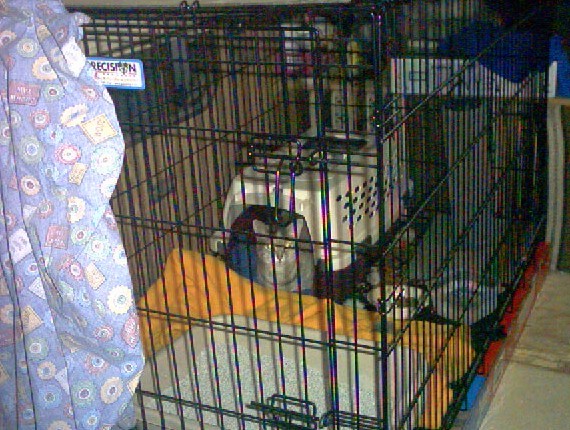 vacation house and taking cat
Questionour permanent home is on a 3 acre semi wooded p
vacation house and taking cat
Questionour permanent home is on a 3 acre semi wooded p
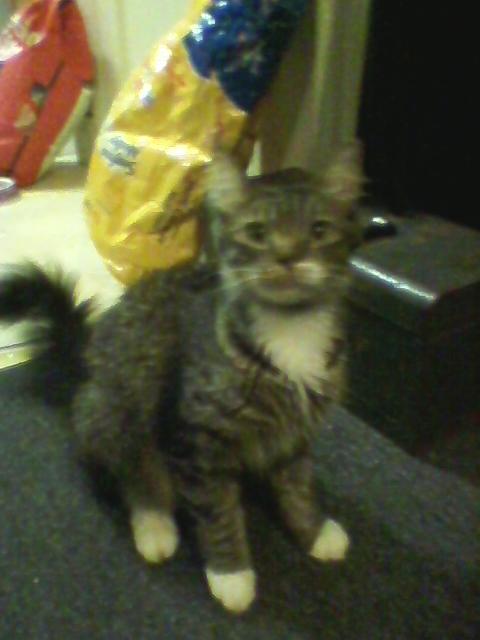 cat identification
Question
pic was from my phone,
i am currently f
cat identification
Question
pic was from my phone,
i am currently f
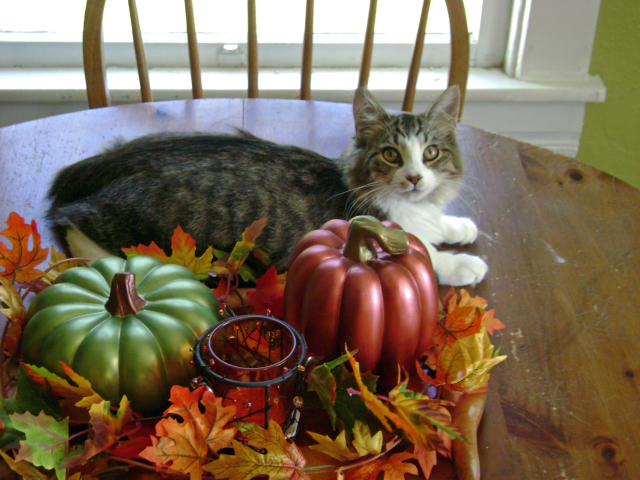 The breed of my 5 1/2 month old kitten
Question
Edmund 5 1/2 months ol
Hi, my husband and I re
The breed of my 5 1/2 month old kitten
Question
Edmund 5 1/2 months ol
Hi, my husband and I re
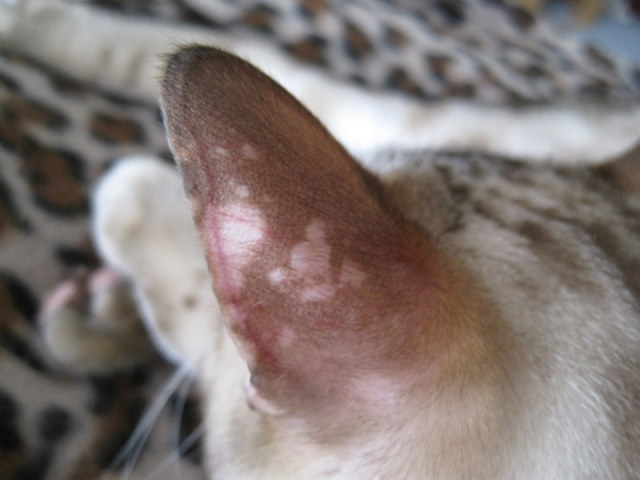 Vitiligo in Pointed Bengal
Question
Possible Vitiligo on B
I have a 1 and a 1/2 ye
Vitiligo in Pointed Bengal
Question
Possible Vitiligo on B
I have a 1 and a 1/2 ye
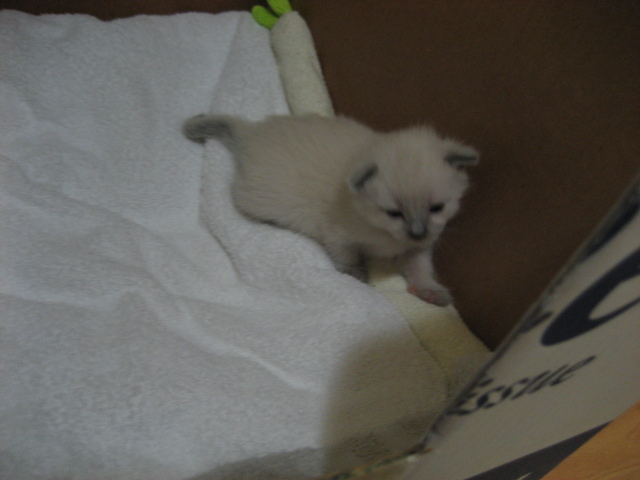 is my kitten blue or blue cream point?
Question
polar bear
hi Jessica, our mommy cat is a blac
is my kitten blue or blue cream point?
Question
polar bear
hi Jessica, our mommy cat is a blac